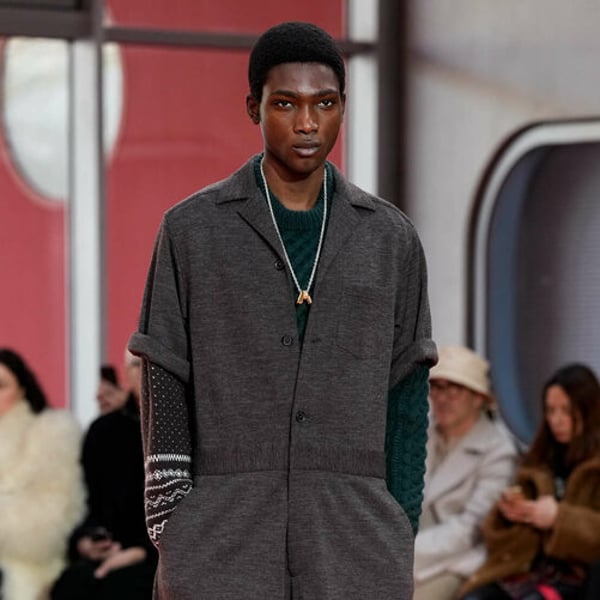Paris Fashion Week ended on a high note on Sunday. Alongside the big names, a host of brands stood out during the final weekend of shows for autumn-winter 2024/25, with collections capable of renewing men’s fashion, drawing on a multitude of cultural influences from the four corners of the world. These included American brand Winnie, Japanese labels Kolor and White Mountaineering, and South Korean label Wooyoungmi.
For her first show on the official calendar, Winnie chose the American Library in Paris, unveiling a collection inspired by jazz musician and surrealist poet Ted Joans, one of the few African-Americans to have taken part in the Beat Generation. Wearing round nerdy glasses and fur hats, the models strolled along the book shelves, looking quite at home. At ease in suits, jogging suits and jeans cinched at the waist with a belt.
No frills, no special effects for the label founded in 2018 in New York, where its clothes are entirely made. Designer Idris Balogun, a Nigerian-American who won the Karl Lagerfeld Prize at the LVMH 2022 Awards, gets straight to the point with clothes made to be worn and a certain sense of allure. With a woollen cap tucked into a trouser pocket, a tie sticking out of a overcoat, a little scarf tied around the neck, a sailor jacket and a beige three-button blazer open over a pink cable jumper, his wardrobe is undeniably stylish.
The designer, who trained with the London tailors of Savile Row after graduating from the Fashion Institute of Technology, went on to work for Burberry and then Tom Ford, where he was director of menswear and made-to-measure. In other words, he is an outstanding tailor who favours natural fibres and exceptional materials, and pays great attention to finish and detail.
Witness the hand-sewn buttonholes, the double collar on an ultra-chic jacket, the trousers with a fine wool drawstring or the jacket with four pockets, closed at the side. The little tweed jacket was perfect, the flowing trousers had just enough slack, and the trench coat fell impeccably. The test was a resounding success for this Paris Fashion Week debut.
Kolor brings together two opposing worlds, the utilitarian and the very chic-glamorous formal wardrobe. The retro style includes waistcoats, pegged trousers, tartan shirts and milleraie velvet suits with elbow patches for an even more old-fashioned effect.
Designer Junichi Abe reflected on the key pieces in men’s wardrobes, how they evolve and how people appropriate them, adding his own touch. Surfing on the current craze for long-lasting clothes and recycled pieces, he made trousers and jackets from what look like old cotton canvas and worn-out denim.
Soiled, torn, covered in paint stains and frayed, they gave the garments a lived-in look. A piece of denim jacket or a scrap of old fabric was inserted into a top or the lapel of a jacket with large visible seams. A canvas jacket with four pockets appeared to be sewn onto a quilted jacket. A mechanic’s overall in cosy jersey.
At the other end of the spectrum, a number of classic garments with perfect cuts were ennobled. Beautiful khaki and navy trench coats decorated with gold rings, or banker’s trousers stitched at the ankle with shiny pinheads, while precious stones or embroidery lit up a collar and a string of gold coins were embedded in a belt.
White Mountaineering explored the theme of travel. Whether a hike, a motorbike trip, a round-the-world train journey or a business-class flight, Yosuke Aizawa imagined a man ready to take on any challenge, thanks to a complete and versatile wardrobe that was both formal and highly technical.
Windbreakers and waterproof jackets featured pockets, as did the nappa leather jacket. Lightweight anoraks were easy to slip over suit jackets. Large parkas and down jackets provided protection from the cold. Small coats matched trousers in high-performance menswear fabrics. The Teddy jacket and a sweater with a large W logo were made from ultra-fine wools.
Alongside these sober, techno-sporty looks, the brand also offered warmer, more colourful outfits, including superb jacquard jumpers – its speciality – as well as shirts, ensembles in different shades of tartan, and even very comfortable lined slippers in different shades, for outdoor wear. The large canvas travel bags also came in a range of colours, while the square wheeled suitcases, carried by hand were only black.
Wooyoungmi, which also likes to mix styles and create a dialogue between the Far East and the West, this season delivered a very easy, wearable collection with a Korean twist. Madame Woo, that is to say Woo Young Mi, the founder of the fashion house, who took over as creative director in March 2020 after handing over the reins to her daughter, had the good idea of drawing a portrait of Seoulites, not fantasised through Western clichés, but as they really are, through “an international urban style, fused with an instinctive and very personal way of dressing specific to the inhabitants of the South Korean capital, whom everyone thinks they know, without ever having been there,” the house points out.
The designer imagined a businessman who wore a collarless wool jacket over his grey suit, or even a polo shirt, as well as denim outfits under an austere black coat. A student wore a parka and a long-sleeved rugby jersey with the PariSeoul slogan on it, with flannel mini-shorts, or paired a shimmering tweed jacket with a pair of loose denim shorts. To go out in the evening, he wore a sparkling black tracksuit with stripes down the side, which he wore shirtless.
Young girls also personalised their shirt-and-tie uniforms, swapping their college suits for a pair of jeans and a suede jacket or a pea jacket worn over a mini skirt, for a very preppy look. A silk square tied at the front like a tie or in a Lavallière knot completed the look with a retro hat.
Copyright © 2024 FashionNetwork.com All rights reserved.










